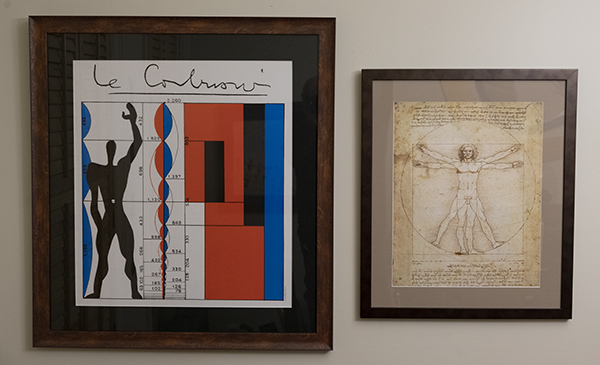logic and proportion
January 2, 2021

The above images – on the left Modular by Le Corbusier and on the right Vitruvian Man by Da Vinci – have finally been united.
I bought the Modular poster when the Wertheimers and I were in Romchampt at Notre-Dame du Haut – the amazing chapel designed by Le Corbusier to commemorate the resistant fighters of World War II. And it’s been in the downstairs big-room since then – some 30 years.
I knew it was based on Da Vinci’s famous Vitruvian Man drawing, but I was always too bashful about putting the two pieces next to each other, mainly because Da Vinci’s man was naked. But time and age change many things; I bought a poster of the famous geometric man and put it next to Modular.
The Vitruvian Man – L’uomo vitruviano – originally known as Le proporzioni del corpo umano secondo Vitruvio – The proportions of the human body according to Vitruvius – is a drawing made by the Italian polymath Leonardo da Vinci in about 1490. It is accompanied by notes based on the work of the Roman architect Vitruvius. The drawing, which is in ink on paper, depicts a man in two superimposed positions with his arms and legs apart and inscribed in a circle and square. – Wikipedia
The Modulor is an anthropometric scale of proportions devised by the Swiss-born French architect Le Corbusier (1887–1965).
It was developed as a visual bridge between two incompatible scales, the Imperial and the metric systems. It is based on the height of a man with his arm raised.
Le Corbusier developed the Modulor in the long tradition of Vitruvius, Leonardo da Vinci’s Vitruvian Man, and other attempts to discover mathematical proportions in the human body and then to use that knowledge to improve both the appearance and function of architecture.The system is based on human measurements, the double unit, the Fibonacci numbers, and the golden ratio. Le Corbusier described it as a “range of harmonious measurements to suit the human scale, universally applicable to architecture and to mechanical things”. – Wikipedia